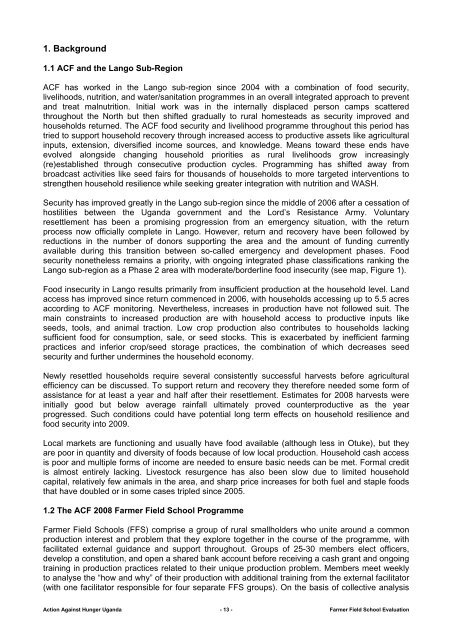Participatory Evaluation of our 2008 - Action Against Hunger
Participatory Evaluation of our 2008 - Action Against Hunger
Participatory Evaluation of our 2008 - Action Against Hunger
Create successful ePaper yourself
Turn your PDF publications into a flip-book with our unique Google optimized e-Paper software.
1. Background<br />
1.1 ACF and the Lango Sub-Region<br />
ACF has worked in the Lango sub-region since 2004 with a combination <strong>of</strong> food security,<br />
livelihoods, nutrition, and water/sanitation programmes in an overall integrated approach to prevent<br />
and treat malnutrition. Initial work was in the internally displaced person camps scattered<br />
throughout the North but then shifted gradually to rural homesteads as security improved and<br />
households returned. The ACF food security and livelihood programme throughout this period has<br />
tried to support household recovery through increased access to productive assets like agricultural<br />
inputs, extension, diversified income s<strong>our</strong>ces, and knowledge. Means toward these ends have<br />
evolved alongside changing household priorities as rural livelihoods grow increasingly<br />
(re)established through consecutive production cycles. Programming has shifted away from<br />
broadcast activities like seed fairs for thousands <strong>of</strong> households to more targeted interventions to<br />
strengthen household resilience while seeking greater integration with nutrition and WASH.<br />
Security has improved greatly in the Lango sub-region since the middle <strong>of</strong> 2006 after a cessation <strong>of</strong><br />
hostilities between the Uganda government and the Lord’s Resistance Army. Voluntary<br />
resettlement has been a promising progression from an emergency situation, with the return<br />
process now <strong>of</strong>ficially complete in Lango. However, return and recovery have been followed by<br />
reductions in the number <strong>of</strong> donors supporting the area and the amount <strong>of</strong> funding currently<br />
available during this transition between so-called emergency and development phases. Food<br />
security nonetheless remains a priority, with ongoing integrated phase classifications ranking the<br />
Lango sub-region as a Phase 2 area with moderate/borderline food insecurity (see map, Figure 1).<br />
Food insecurity in Lango results primarily from insufficient production at the household level. Land<br />
access has improved since return commenced in 2006, with households accessing up to 5.5 acres<br />
according to ACF monitoring. Nevertheless, increases in production have not followed suit. The<br />
main constraints to increased production are with household access to productive inputs like<br />
seeds, tools, and animal traction. Low crop production also contributes to households lacking<br />
sufficient food for consumption, sale, or seed stocks. This is exacerbated by inefficient farming<br />
practices and inferior crop/seed storage practices, the combination <strong>of</strong> which decreases seed<br />
security and further undermines the household economy.<br />
Newly resettled households require several consistently successful harvests before agricultural<br />
efficiency can be discussed. To support return and recovery they therefore needed some form <strong>of</strong><br />
assistance for at least a year and half after their resettlement. Estimates for <strong>2008</strong> harvests were<br />
initially good but below average rainfall ultimately proved counterproductive as the year<br />
progressed. Such conditions could have potential long term effects on household resilience and<br />
food security into 2009.<br />
Local markets are functioning and usually have food available (although less in Otuke), but they<br />
are poor in quantity and diversity <strong>of</strong> foods because <strong>of</strong> low local production. Household cash access<br />
is poor and multiple forms <strong>of</strong> income are needed to ensure basic needs can be met. Formal credit<br />
is almost entirely lacking. Livestock resurgence has also been slow due to limited household<br />
capital, relatively few animals in the area, and sharp price increases for both fuel and staple foods<br />
that have doubled or in some cases tripled since 2005.<br />
1.2 The ACF <strong>2008</strong> Farmer Field School Programme<br />
Farmer Field Schools (FFS) comprise a group <strong>of</strong> rural smallholders who unite around a common<br />
production interest and problem that they explore together in the c<strong>our</strong>se <strong>of</strong> the programme, with<br />
facilitated external guidance and support throughout. Groups <strong>of</strong> 25-30 members elect <strong>of</strong>ficers,<br />
develop a constitution, and open a shared bank account before receiving a cash grant and ongoing<br />
training in production practices related to their unique production problem. Members meet weekly<br />
to analyse the “how and why” <strong>of</strong> their production with additional training from the external facilitator<br />
(with one facilitator responsible for f<strong>our</strong> separate FFS groups). On the basis <strong>of</strong> collective analysis<br />
<strong>Action</strong> <strong>Against</strong> <strong>Hunger</strong> Uganda - 13 - Farmer Field School <strong>Evaluation</strong>

















